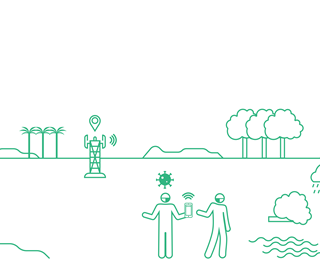Evidence-based policy-making requires reliable sources of accurate data to inform decisions.
Call detail records (CDRs) provide an exciting source of data in otherwise information-scarce contexts. This means it can provide insights for a broad range of applications related to development in Low- and Middle-Income Countries (LMICs) including:
- Infrastructure planning
- Poverty alleviation
- Tax collection and administration
- Labour markets and industrial strategy
- Census and survey planning
In order to produce these insights, CDR data can be used to generate different types of statistics, such as:
- Population and internal migration statistics
- Socio-economic statistics
- Tourism statistics
- Information society statistics
Population statistics
A broad range of policy questions are dependent on a robust understanding of how people are distributed across a country or region and how they move between different areas.
CDR data can help decision makers better understand the distribution of a population and how it changes over time, providing important insights such as the requirements for services and infrastructure and the labour available in an area. This is especially relevant in the context of development as internal migrants may be more likely to be marginalised or lack access to resources and services.
Areas with large fluctuations in the number of people staying in the area, for example due to seasonal migrations, can experience large variations in the demands on infrastructure and services.
CDR data can be used to monitor variations in population distribution which may put pressure on infrastructure and services or even predict demand. In Senegal, CDR data has been shown to predict electricity demand and could be used to estimate consumption and peak demand in an area. CDR data could similarly be used to assess the variation in demand for other utilities, as well as government and public health services.
Up-to-date information on the number of people living in an area and how this varies over time also has important implications for labour markets, and therefore labour strategy and policies.
CDR data can be used to help generate useful labour market indicators. This is particularly useful in areas with substantial seasonal migration for work, for example in response to seasonal demands for workers in the agricultural or tourism industries.
CDR data can also be used to study unemployment, if it contains additional features which provide social and financial information (i.e. an identifier of the other subscriber in a call or SMS event, mobile top-up and expenditure data, mobile money data). Sundsøy et al. demonstrated that subscribers’ employment status can be predicted from CDR data, which when aggregated with many subscribers and anonymised can be used to generate labour market indicators. Furthermore, this method could be used to study other categories of employment such as teachers and students or the retired, albeit with lower accuracy.
By providing a better understanding of how people are distributed across a country, CDR data can also help increase the efficiency of government administration.
CDR data can support the planning of censuses and surveys, further improving policy-makers’ access to information to support decision-making. CDR data is especially useful for surveying specific groups within a population based on their mobility patterns, such as nomadic groups or seasonal workers.
Socio-economic statistics
Poverty alleviation is a priority issue in LMICs but can be hindered by a lack of information to support targeted, evidence-based policy-making.
Often those most in need of support are those we have least information about. CDR data can be used to help generate informative socio-economic statistics to support decision-makers in this context.
CDR data can be used to generate poverty indicators, if it contains additional features which provide social and financial data (i.e. an identifier of the other subscriber in a call or SMS event, mobile top-up and expenditure data, mobile money data). In Bangladesh, Steele et al. used CDR data to generate poverty indicators for the whole country with high granularity. Their model was also further improved when combined with remote sensing data. This demonstrated the possibility of being able to monitor poverty indicators with high spatial and temporal resolution in LMICs with limited capacity to support traditional methods of data collection.Similarly, Sundsøy et al. demonstrated that similar CDR data can be used to predict the employment status of subscribers, including whether they are likely to be unemployed, a student or retired. When these profiles are aggregated and anonymised they can be used to provide a range of useful socio-economic indicators, such as estimates of the proportion of people who are unemployed or the proportion in full time education.

